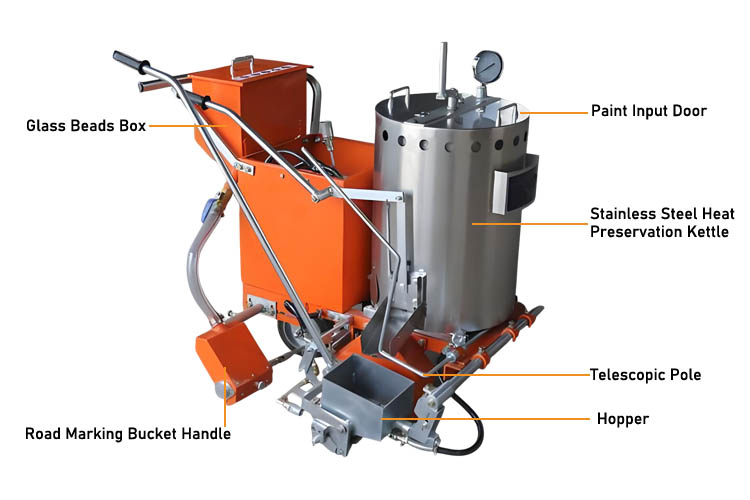Road Line Marking Machine Telescopic Pole – How It Works and Importance
The telescopic pole (also called an pointing needle or positioning rod) is an important mechanical accessory for a road marking machine. It helps the operator maintain a fixed, precise distance between the marking machine and the edge of the road, curb or other reference point, ensuring that the markings are straight, parallel and consistent.
In the following, we will explore its functions, working mechanisms, benefits and best practices to achieve optimal performance.

1. Main functions of a road marking machine Telescopic Pole
(1) Ensures precise parallel markings
- Maintains a preset distance (e.g. 30 cm, 50 cm or 1.5 m) between the marking machine and the edge of the road.
- Eliminates the human error of manual measurement and ensures straight, uniform lines for driveways, parking spaces and signs.
(2) Improve efficiency of road marking projects
- Operators no longer need to stop frequently to check spacing, simply glide along the curb or reference line.
- Reduces labor time by up to 40% compared to freehand marking.
(3) Adapts to complex road layouts
- Flexible extensions and rotations allow for smooth marking on curves, traffic circles and irregular roads.
- Ideal for parking lots, highways and airport runways where accuracy is critical.
2. How does the road marking machine telescopic pole work?
Structure & Components
- Telescopic Pole Shaft: Made of lightweight aluminum or carbon fiber, adjustable length (typically 2-5 meters).
- Guide Wheels/Sliders: Fitted with rolling wheels or low friction pads at the end to glide smoothly along the kerb or edge of the road.
- Mounting Bracket: Rod is fixed to the marking machine with adjustable clamps for horizontal/vertical alignment.
Working Process
- Setting the required distance – Adjust the length of the pole to the marking requirements (e.g. 1 meter from the curb).
- Align with curb – Align the guide wheel with the curb or boundary.
- Mark the line as you move – as the machine moves, the pole automatically adapts to the bends in the road, keeping the line parallel to the line.
3. Best Applications for Telescopic Guide Poles
- Road lane marking (centerlines, edge lines, bike lanes)
- Parking lot demarcation (ensuring consistent space between parking spaces)
- Airport and warehouse marking (long, straight runways require precision)
- Poor visibility conditions (night work or foggy environments that make it difficult to visually align)
4. Road Marking Machine Telescopic Pole Advantages and Limitations
Advantages
- Cost effective – no electronics or sensors required; minimal maintenance.
- Reliability in harsh conditions – can operate in rain, dust or extreme temperatures.
- Easy to use – no training required; ideal for small to medium sized contractors.
Limitations
- Requires physical contact – works best in smooth, well-defined edges (e.g., curbs).
- Limited length – wide roads or runways may require extra long poles.
- Manual adjustment required – Sharp turns may require operator intervention.
5. Maintenance & Usage Tips
- Regularly lubricate joints – prevents stiffness and ensures smooth extension.
- Replace worn wheels/sliders – prevents damage to kerbs and improves accuracy.
- Calibrate before use – verify distance settings with a tape measure.
- Retract during transportation – Avoid bending or breaking the pole.
6. Telescopic Pole vs. Electronic Guidance Systems
| Feature | Telescopic Pole | Electronic System |
|---|---|---|
| Cost | Low (100–100–500) | High ($2,000+) |
| Precision | ±1–2 cm | ±0.5 cm (laser/GPS) |
| Durability | Works in all weather | Sensitive to dust/moisture |
| Best For | Small/medium projects | Large-scale, high-precision jobs |
Road marking machine telescopic poles are a simple but indispensable tool for contractors who need to mark quickly, accurately and economically. While electronic systems are more accurate, telescopic poles are still the preferred choice for most road marking projects due to their reliability and ease of use.
Looking for a high-quality telescopic pole marking machine? Contact us for expert advice!
